engine overheat HONDA CR-V 2015 RM1, RM3, RM4 / 4.G Quick Guide
[x] Cancel search | Manufacturer: HONDA, Model Year: 2015, Model line: CR-V, Model: HONDA CR-V 2015 RM1, RM3, RM4 / 4.GPages: 81, PDF Size: 14.87 MB
Page 4 of 81
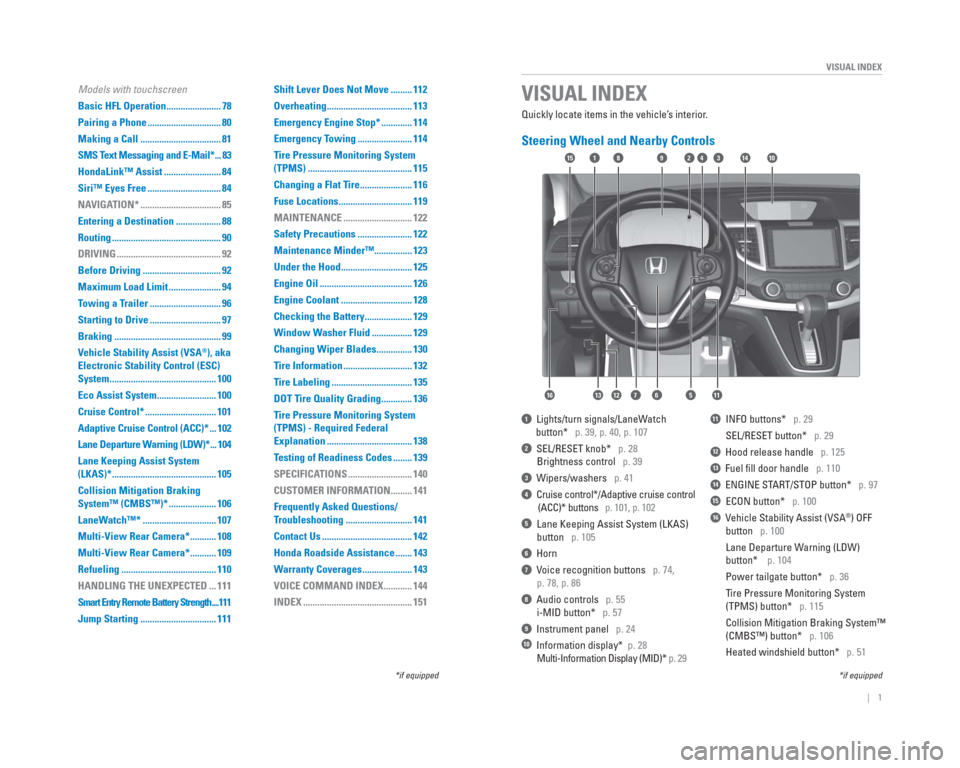
| 1
VISUAL INDEX
Quickly locate items in the vehicle’s interior.
Steering Wheel and Nearby Controls
1 Lights/turn signals/LaneWatch
button* p. 39, p. 40, p. 107
2 SEL/RESET knob* p. 28
Brightness control p. 39
3 Wipers/washers p. 41
4 Cruise control*/Adaptive cruise control
(ACC)* buttons p. 101, p. 102
5 Lane Keeping Assist System (LKAS)
button p. 105
6 Horn
7 Voice recognition buttons p. 74,
p. 78, p. 86
8 Audio controls p. 55
i-MID button* p. 57
9 Instrument panel p. 24
10 Information display* p. 28
Multi-Information Display (MID)* p. 29
11 INFO buttons* p. 29
SEL/RESET button* p. 29
12 Hood release handle p. 125
13 Fuel fi ll door handle p. 110
14 ENGINE START/STOP button* p. 97
15 ECON button* p. 100
16 Vehicle Stability Assist (VSA®) OFF
button p. 100
Lane Departure Warning (LDW)
button* p. 104
Power tailgate button* p. 36
Tire Pressure Monitoring System
(TPMS) button* p. 115
Collision Mitigation Braking System™
(CMBS™) button* p. 106
Heated windshield button* p. 51
VISUAL INDEX
*if equipped
*if equipped
92
567111213
1815341014
16
Models with touchscreen
Basic HFL Operation ....................... 78
Pairing a Phone ............................... 80
Making a Call .................................. 81
SMS Text Messaging and E-Mail* ... 83
HondaLink™ Assist ........................ 84
Siri™ Eyes Free ............................... 84
NAVIGATION* .................................. 85
Entering a Destination ................... 88
Routing .............................................. 90
DRIVING ............................................ 92
Before Driving ................................. 92
Maximum Load Limit ...................... 94
Towing a Trailer .............................. 96
Starting to Drive .............................. 97
Braking ............................................. 99
Vehicle Stability Assist (VSA
®), aka
Electronic Stability Control (ESC)
System ............................................. 100
Eco Assist System ......................... 100
Cruise Control* .............................. 101
Adaptive Cruise Control (ACC)* ... 102
Lane Departure Warning (LDW)* ... 104
Lane Keeping Assist System
(LKAS)* ............................................ 105
Collision Mitigation Braking
System™ (CMBS™)* .................... 106
LaneWatch™* ............................... 107
Multi-View Rear Camera* ........... 108
Multi-View Rear Camera* ........... 109
Refueling ........................................ 110
HANDLING THE UNEXPECTED ... 111
Smart Entry Remote Battery Strength ....111
Jump Starting ................................ 111 Shift Lever Does Not Move ......... 112
Overheating .................................... 113
Emergency Engine Stop* ............. 114
Emergency Towing ....................... 114
Tire Pressure Monitoring System
(TPMS) ............................................ 115
Changing a Flat Tire ...................... 116
Fuse Locations ............................... 119
MAINTENANCE ............................. 122
Safety Precautions ....................... 122
Maintenance Minder™................ 123
Under the Hood .............................. 125
Engine Oil ....................................... 126
Engine Coolant .............................. 128
Checking the Battery .................... 129
Window Washer Fluid ................. 129
Changing Wiper Blades ............... 130
Tire Information ............................. 132
Tire Labeling .................................. 135
DOT Tire Quality Grading ............. 136
Tire Pressure Monitoring System
(TPMS) - Required Federal
Explanation .................................... 138
Testing of Readiness Codes ........ 139
SPECIFICATIONS ........................... 140
CUSTOMER INFORMATION ......... 141
Frequently Asked Questions/
Troubleshooting ............................ 141
Contact Us ...................................... 142
Honda Roadside Assistance ....... 143
Warranty Coverages ..................... 143
VOICE COMMAND INDEX ............ 144
INDEX .............................................. 151
Page 16 of 81
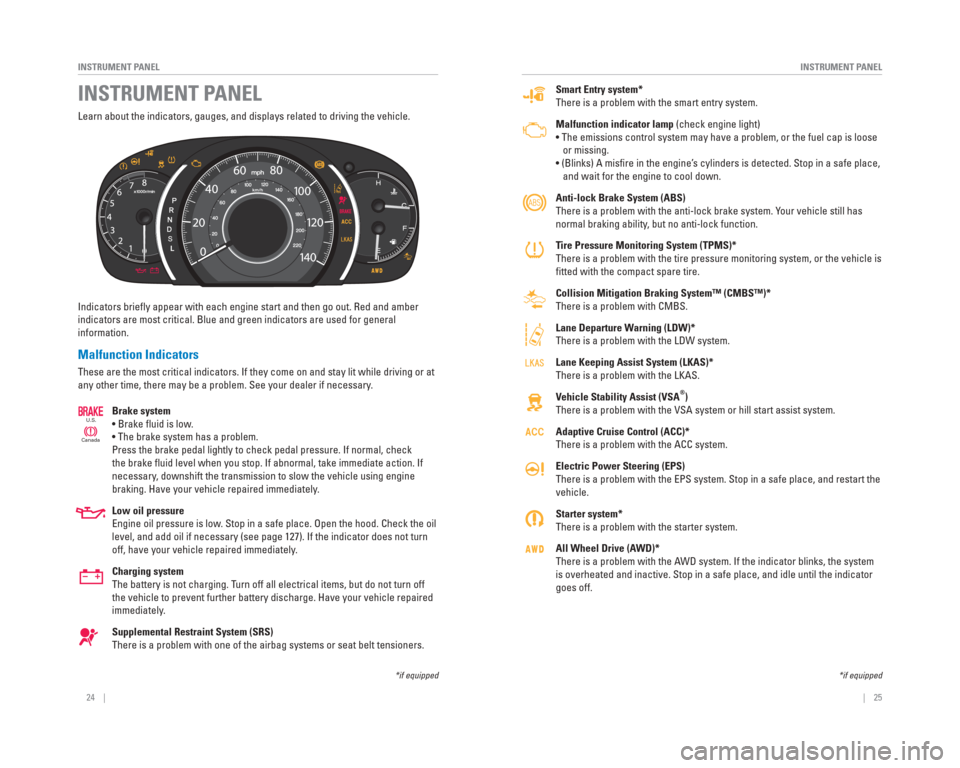
24 || 25
INSTRUMENT PANEL
INSTRUMENT PANEL
Smart Entry system*
There is a problem with the smart entry system.
Malfunction indicator lamp (check engine light)
• The emissions control system may have a problem, or the fuel cap is\
loose
or missing.
• (Blinks) A misfi re in the engine’s cylinders is detected. Stop in a safe place,
and wait for the engine to cool down.
Anti-lock Brake System ( ABS)
There is a problem with the anti-lock brake system. Your vehicle still has
normal braking ability, but no anti-lock function.
Tire Pressure Monitoring System ( TPMS)*
There is a problem with the tire pressure monitoring system, or the vehi\
cle is
fi tted with the compact spare tire.
Collision Mitigation Braking System™ (CMBS™)*
There is a problem with CMBS.
Lane Departure Warning (LDW)*
There is a problem with the LDW system.
Lane Keeping Assist System (LKAS)*
There is a problem with the LKAS.
Vehicle Stability Assist ( VSA
®)
There is a problem with the VSA system or hill start assist system.
Adaptive Cruise Control (ACC)*
There is a problem with the ACC system.
Electric Power Steering (EPS)
There is a problem with the EPS system. Stop in a safe place, and restar\
t the
vehicle.
Starter system*
There is a problem with the starter system.
All Wheel Drive ( AWD)*
There is a problem with the AWD system. If the indicator blinks, the system
is overheated and inactive. Stop in a safe place, and idle until the ind\
icator
goes off.
Learn about the indicators, gauges, and displays related to driving the \
vehicle.
Indicators briefl y appear with each engine start and then go out. Red and amber
indicators are most critical. Blue and green indicators are used for gen\
eral
information.
Malfunction Indicators
These are the most critical indicators. If they come on and stay lit whi\
le driving or at
any other time, there may be a problem. See your dealer if necessary.
Brake system
• Brake fl uid is low.
• The brake system has a problem.
Press the brake pedal lightly to check pedal pressure. If normal, check \
the brake fl uid level when you stop. If abnormal, take immediate action. If
necessary, downshift the transmission to slow the vehicle using engine
braking. Have your vehicle repaired immediately.
Low oil pressure
Engine oil pressure is low. Stop in a safe place. Open the hood. Check the oil
level, and add oil if necessary (see page 127). If the indicator does \
not turn
off, have your vehicle repaired immediately.
Charging system
The battery is not charging. Turn off all electrical items, but do not turn off
the vehicle to prevent further battery discharge. Have your vehicle repa\
ired
immediately.
Supplemental Restraint System (SRS)
There is a problem with one of the airbag systems or seat belt tensioner\
s.
CanadaU.S.
INSTRUMENT PANEL
*if equipped
*if equipped
Page 60 of 81
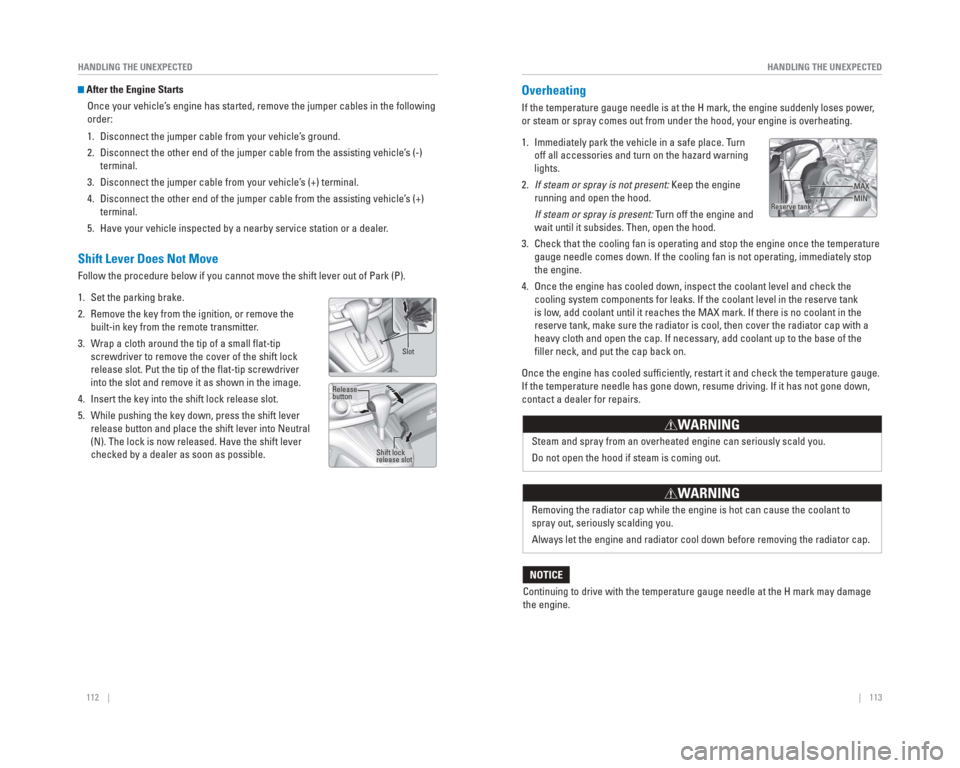
112 || 113
HANDLING THE UNEXPECTED
HANDLING THE UNEXPECTED
After the Engine Starts
Once your vehicle’s engine has started, remove the jumper cables in the following
order:
1. Disconnect the jumper cable from your vehicle’s ground.
2. Disconnect the other end of the jumper cable from the assisting vehicle’\
s (-) terminal.
3. Disconnect the jumper cable from your vehicle’s (+) terminal.
4. Disconnect the other end of the jumper cable from the assisting vehicle’\
s (+) terminal.
5. Have your vehicle inspected by a nearby service station or a dealer.
Shift Lever Does Not Move
Follow the procedure below if you cannot move the shift lever out of Par\
k (P).
1. Set the parking brake.
2. Remove the key from the ignition, or remove the built-in key from the remote transmitter.
3. Wrap a cloth around the tip of a small fl at-tip screwdriver to remove the cover of the shift lock
release slot. Put the tip of the fl at-tip screwdriver
into the slot and remove it as shown in the image.
4. Insert the key into the shift lock release slot.
5. While pushing the key down, press the shift lever release button and place the shift lever into Neutral
(N). The lock is now released. Have the shift lever
checked by a dealer as soon as possible.
Slot
Release
button
Shift lock
release slot
Overheating
If the temperature gauge needle is at the H mark, the engine suddenly lo\
ses power,
or steam or spray comes out from under the hood, your engine is overheat\
ing.
1. Immediately park the vehicle in a safe place. Turn off all accessories and turn on the hazard warning
lights.
2. If steam or spray is not present: Keep the engine
running and open the hood.
If steam or spray is present: Turn off the engine and wait until it subsides. Then, open the hood.
3. Check that the cooling fan is operating and stop the engine once the tem\
perature gauge needle comes down. If the cooling fan is not operating, immediatel\
y stop
the engine.
4. Once the engine has cooled down, inspect the coolant level and check the\
cooling system components for leaks. If the coolant level in the reserve\
tank
is low, add coolant until it reaches the MAX mark. If there is no coolant in t\
he
reserve tank, make sure the radiator is cool, then cover the radiator ca\
p with a
heavy cloth and open the cap. If necessary, add coolant up to the base of the
fi ller neck, and put the cap back on.
Once the engine has cooled suffi ciently, restart it and check the temperature gauge.
If the temperature needle has gone down, resume driving. If it has not g\
one down,
contact a dealer for repairs.
Reserve tank
MAX
MIN
Steam and spray from an overheated engine can seriously scald you.
Do not open the hood if steam is coming out.
WARNING
Removing the radiator cap while the engine is hot can cause the coolant \
to
spray out, seriously scalding you.
Always let the engine and radiator cool down before removing the radiato\
r cap.
WARNING
Continuing to drive with the temperature gauge needle at the H mark may \
damage
the engine.
NOTICE
Page 61 of 81
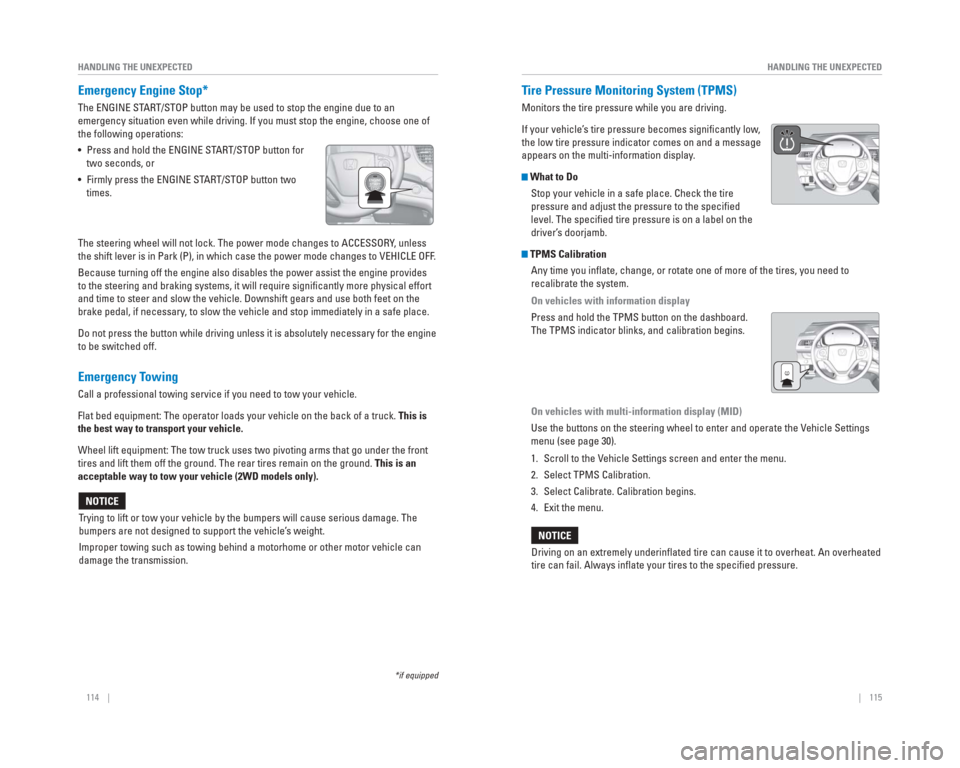
114 || 115
HANDLING THE UNEXPECTED
HANDLING THE UNEXPECTED
Emergency Engine Stop*
The ENGINE START/STOP button may be used to stop the engine due to an
emergency situation even while driving. If you must stop the engine, cho\
ose one of
the following operations:
• Press and hold the ENGINE START/STOP button for
two seconds, or
• Firmly press the ENGINE START/STOP button two times.
The steering wheel will not lock. The power mode changes to ACCESSORY, unless
the shift lever is in Park (P), in which case the power mode changes t\
o VEHICLE OFF.
Because turning off the engine also disables the power assist the engine\
provides
to the steering and braking systems, it will require signifi cantly more physical effort
and time to steer and slow the vehicle. Downshift gears and use both fee\
t on the
brake pedal, if necessary, to slow the vehicle and stop immediately in a safe place.
Do not press the button while driving unless it is absolutely necessary \
for the engine
to be switched off.
Emergency Towing
Call a professional towing service if you need to tow your vehicle.
Flat bed equipment: The operator loads your vehicle on the back of a tru\
ck. This is
the best way to transport your vehicle.
Wheel lift equipment: The tow truck uses two pivoting arms that go under\
the front
tires and lift them off the ground. The rear tires remain on the ground.\
This is an
acceptable way to tow your vehicle (2WD models only).
Trying to lift or tow your vehicle by the bumpers will cause serious dama\
ge. The
bumpers are not designed to support the vehicle’s weight.
Improper towing such as towing behind a motorhome or other motor vehicle\
can
damage the transmission.
NOTICE
*if equipped
Tire Pressure Monitoring System ( TPMS)
Monitors the tire pressure while you are driving.
If your vehicle’s tire pressure becomes signifi cantly low,
the low tire pressure indicator comes on and a message
appears on the multi-information display.
What to Do Stop your vehicle in a safe place. Check the tire
pressure and adjust the pressure to the specifi ed
level. The specifi ed tire pressure is on a label on the
driver’s doorjamb.
TPMS CalibrationAny time you infl ate, change, or rotate one of more of the tires, you need to
recalibrate the system.
On vehicles with information display
Press and hold the TPMS button on the dashboard.
The TPMS indicator blinks, and calibration begins.
On vehicles with multi-information display (MID)
Use the buttons on the steering wheel to enter and operate the Vehicle Settings
menu (see page 30).
1. Scroll to the Vehicle Settings screen and enter the menu.
2. Select TPMS Calibration.
3. Select Calibrate. Calibration begins.
4. Exit the menu.
Driving on an extremely underinfl ated tire can cause it to overheat. An overheated
tire can fail. Always infl ate your tires to the specifi ed pressure.
NOTICE
Page 73 of 81
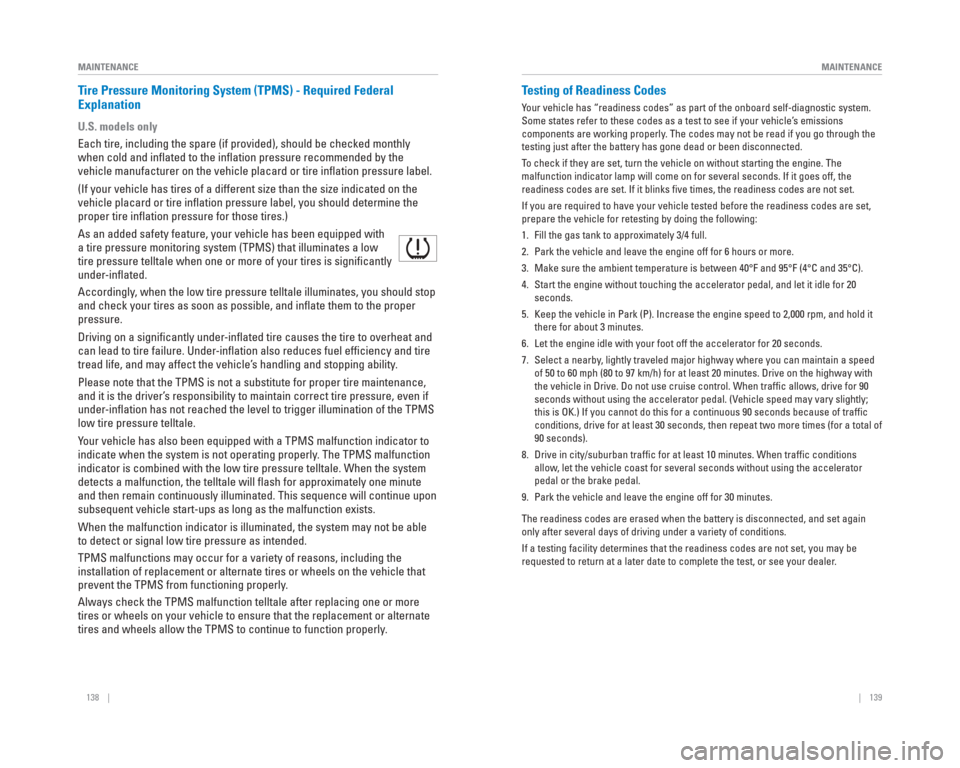
138 || 139
MAINTENANCE
MAINTENANCE
Tire Pressure Monitoring System ( TPMS) - Required Federal
Explanation
U.S. models only
Each tire, including the spare (if provided), should be checked monthl\
y
when cold and infl ated to the infl ation pressure recommended by the
vehicle manufacturer on the vehicle placard or tire infl ation pressure label.
(If your vehicle has tires of a different size than the size indicated \
on the
vehicle placard or tire infl ation pressure label, you should determine the
proper tire infl ation pressure for those tires.)
As an added safety feature, your vehicle has been equipped with
a tire pressure monitoring system (TPMS) that illuminates a low
tire pressure telltale when one or more of your tires is signifi cantly
under-infl ated.
Accordingly, when the low tire pressure telltale illuminates, you should stop
and check your tires as soon as possible, and infl ate them to the proper
pressure.
Driving on a signifi cantly under-infl ated tire causes the tire to overheat and
can lead to tire failure. Under-infl ation also reduces fuel effi ciency and tire
tread life, and may affect the vehicle’s handling and stopping ability.
Please note that the TPMS is not a substitute for proper tire maintenanc\
e,
and it is the driver’s responsibility to maintain correct tire pressure, even if
under-infl ation has not reached the level to trigger illumination of the TPMS
low tire pressure telltale.
Your vehicle has also been equipped with a TPMS malfunction indicator to \
indicate when the system is not operating properly. The TPMS malfunction
indicator is combined with the low tire pressure telltale. When the syst\
em
detects a malfunction, the telltale will fl ash for approximately one minute
and then remain continuously illuminated. This sequence will continue up\
on
subsequent vehicle start-ups as long as the malfunction exists.
When the malfunction indicator is illuminated, the system may not be abl\
e
to detect or signal low tire pressure as intended.
TPMS malfunctions may occur for a variety of reasons, including the
installation of replacement or alternate tires or wheels on the vehicle \
that
prevent the TPMS from functioning properly.
Always check the TPMS malfunction telltale after replacing one or more
tires or wheels on your vehicle to ensure that the replacement or altern\
ate
tires and wheels allow the TPMS to continue to function properly.
Testing of Readiness Codes
Your vehicle has “readiness codes” as part of the onboard self-diag\
nostic system.
Some states refer to these codes as a test to see if your vehicle’s emissions
components are working properly. The codes may not be read if you go through the
testing just after the battery has gone dead or been disconnected.
To check if they are set, turn the vehicle on without starting the engine\
. The
malfunction indicator lamp will come on for several seconds. If it goes \
off, the
readiness codes are set. If it blinks fi ve times, the readiness codes are not set.
If you are required to have your vehicle tested before the readiness cod\
es are set,
prepare the vehicle for retesting by doing the following:
1. Fill the gas tank to approximately 3/4 full.
2. Park the vehicle and leave the engine off for 6 hours or more.
3. Make sure the ambient temperature is between 40°F and 95°F (4°\
C and 35°C).
4. Start the engine without touching the accelerator pedal, and let it idle\
for 20
seconds.
5. Keep the vehicle in Park (P). Increase the engine speed to 2,000 rpm, \
and hold it there for about 3 minutes.
6. Let the engine idle with your foot off the accelerator for 20 seconds.
7. Select a nearby, lightly traveled major highway where you can maintain a speed of 50 to 60 mph (80 to 97 km/h) for at least 20 minutes. Drive on the \
highway with
the vehicle in Drive. Do not use cruise control. When traffi c allows, drive for 90
seconds without using the accelerator pedal. (Vehicle speed may vary slightly;
this is OK.) If you cannot do this for a continuous 90 seconds because \
of traffi c
conditions, drive for at least 30 seconds, then repeat two more times (\
for a total of
90 seconds).
8. Drive in city/suburban traffi c for at least 10 minutes. When traffi c conditions allow, let the vehicle coast for several seconds without using the accelerato\
r
pedal or the brake pedal.
9. Park the vehicle and leave the engine off for 30 minutes.
The readiness codes are erased when the battery is disconnected, and set\
again
only after several days of driving under a variety of conditions.
If a testing facility determines that the readiness codes are not set, y\
ou may be
requested to return at a later date to complete the test, or see your de\
aler.
Page 80 of 81
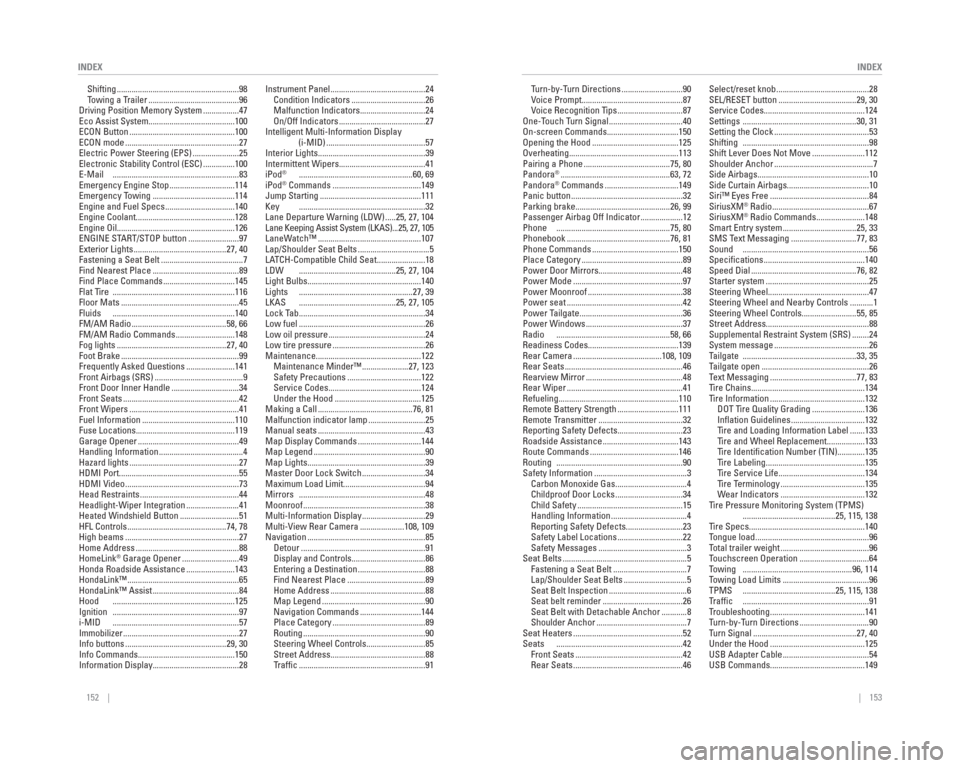
152 || 153
INDEX
INDEX
Shifting ..........................................................98
Towing a Trailer ...........................................96
Driving Position Memory System .................47
Eco Assist System.........................................100
ECON Button ..................................................100
ECON mode ......................................................27
Electric Power Steering (EPS) ......................25
Electronic Stability Control (ESC) ...............100
E-Mail ............................................................83
Emergency Engine Stop ...............................114
Emergency Towing .......................................114
Engine and Fuel Specs .................................140
Engine Coolant...............................................128
Engine Oil........................................................126
ENGINE START/STOP button ........................97
Exterior Lights ............................................27, 40
Fastening a Seat Belt .......................................7
Find Nearest Place .........................................89
Find Place Commands ..................................145
Flat Tire ..........................................................116
Floor Mats ........................................................45
Fluids ..........................................................140
FM/AM Radio .............................................58, 66
FM/AM Radio Commands ............................148
Fog lights ....................................................27, 40
Foot Brake ........................................................99
Frequently Asked Questions .......................141
Front Airbags (SRS) ..........................................9
Front Door Inner Handle ................................34
Front Seats .......................................................42
Front Wipers ....................................................41
Fuel Information ............................................110
Fuse Locations...............................................119
Garage Opener ................................................49
Handling Information ........................................4
Hazard lights ....................................................27
HDMI Port.........................................................55
HDMI Video ......................................................73
Head Restraints ...............................................44
Headlight-Wiper Integration .........................41
Heated Windshield Button ............................51
HFL Controls ...............................................74, 78
High beams ......................................................27
Home Address .................................................88
HomeLink
® Garage Opener ...........................49
Honda Roadside Assistance .......................143
HondaLink™ .....................................................65
HondaLink™ Assist .........................................84
Hood ..........................................................125
Ignition ............................................................97
i-MID ............................................................57
Immobilizer .......................................................27
Info buttons ................................................29, 30
Info Commands..............................................150
Information Display.........................................28 Instrument Panel .............................................24
Condition Indicators ...................................26
Malfunction Indicators ...............................24
On/Off Indicators .........................................27
Intelligent Multi-Information Display (i-MID) ...............................................57
Interior Lights...................................................39
Intermittent Wipers.........................................41
iPod
® ......................................................60, 69
iPod® Commands ..........................................149
Jump Starting ................................................111
Key ............................................................32
Lane Departure Warning (LDW) .....25, 27, 104
Lane Keeping Assist System (LKAS) ...25, 27, 105
LaneWatch™ .................................................107
Lap/Shoulder Seat Belts ..................................5
LATCH-Compatible Child Seat .......................18
LDW ..............................................25, 27, 104
Light Bulbs......................................................140
Lights ......................................................27, 39
LKAS ..............................................25, 27, 105
Lock Tab ............................................................34
Low fuel ............................................................26
Low oil pressure ..............................................24
Low tire pressure ............................................26
Maintenance..................................................122 Maintenance Minder™ ......................27, 123
Safety Precautions ...................................122
Service Codes ............................................124
Under the Hood .........................................125
Making a Call .............................................76, 81
Malfunction indicator lamp ...........................25
Manual seats ...................................................43
Map Display Commands ..............................144
Map Legend .....................................................90
Map Lights........................................................39
Master Door Lock Switch ..............................34
Maximum Load Limit.......................................94
Mirrors ............................................................48
Moonroof ..........................................................38
Multi-Information Display ..............................29
Multi-View Rear Camera .....................108, 109
Navigation ........................................................85 Detour ...........................................................91
Display and Controls ...................................86
Entering a Destination ................................88
Find Nearest Place .....................................89
Home Address .............................................88
Map Legend .................................................90
Navigation Commands .............................144
Place Category ............................................89
Routing ..........................................................90
Steering Wheel Controls ............................85
Street Address .............................................88
Traffi c ............................................................91 Turn-by-Turn Directions .............................90
Voice Prompt................................................87
Voice Recognition Tips ...............................87
One-Touch Turn Signal ...................................40
On-screen Commands..................................150
Opening the Hood .........................................125
Overheating....................................................113
Pairing a Phone .........................................75, 80
Pandora
® ....................................................63, 72
Pandora® Commands ...................................149
Panic button .....................................................32
Parking brake.............................................26, 99
Passenger Airbag Off Indicator ....................12
Phone ......................................................75, 80
Phonebook .................................................76, 81
Phone Commands .........................................150
Place Category ................................................89
Power Door Mirrors........................................48
Power Mode ....................................................97
Power Moonroof .............................................38
Power seat .......................................................42
Power Tailgate .................................................36
Power Windows ..............................................37
Radio ......................................................58, 66
Readiness Codes...........................................139
Rear Camera ..........................................108, 109
Rear Seats ........................................................46
Rearview Mirror ..............................................48
Rear Wiper .......................................................41
Refueling.........................................................110
Remote Battery Strength .............................111
Remote Transmitter ........................................32
Reporting Safety Defects...............................23
Roadside Assistance ....................................143
Route Commands ..........................................146
Routing ............................................................90
Safety Information ............................................3 Carbon Monoxide Gas ..................................4
Childproof Door Locks ................................34
Child Safety ..................................................15
Handling Information ....................................4
Reporting Safety Defects ...........................23
Safety Label Locations ...............................22
Safety Messages ..........................................3
Seat Belts ...........................................................5 Fastening a Seat Belt ...................................7
Lap/Shoulder Seat Belts ..............................5
Seat Belt Inspection .....................................6
Seat belt reminder ......................................26
Seat Belt with Detachable Anchor ............8
Shoulder Anchor ...........................................7
Seat Heaters ....................................................52
Seats ............................................................42 Front Seats ...................................................42
Rear Seats ....................................................46 Select/reset knob ............................................28
SEL/RESET button .....................................29, 30
Service Codes................................................124
Settings ......................................................30, 31
Setting the Clock .............................................53
Shifting ............................................................98
Shift Lever Does Not Move .........................112
Shoulder Anchor ...............................................7
Side Airbags.....................................................10
Side Curtain Airbags.......................................10
Siri™ Eyes Free ...............................................84
SiriusXM
® Radio ..............................................67
SiriusXM® Radio Commands .......................148
Smart Entry system ...................................25, 33
SMS Text Messaging ...............................77, 83
Sound ............................................................56
Specifi cations ................................................140
Speed Dial ..................................................76, 82
Starter system .................................................25
Steering Wheel................................................47
Steering Wheel and Nearby Controls ...........1
Steering Wheel Controls..........................55, 85
Street Address.................................................88
Supplemental Restraint System (SRS) ........24
System message .............................................26
Tailgate ......................................................33, 35
Tailgate open ...................................................26
Text Messaging .........................................77, 83
Tire Chains ......................................................134
Tire Information .............................................132 DOT Tire Quality Grading .........................136
Infl ation Guidelines ...................................132
Tire and Loading Information Label .......133
Tire and Wheel Replacement ..................133
Tire Identifi cation Number (TIN) .............135
Tire Labeling ...............................................135
Tire Service Life .........................................134
Tire Terminology ........................................135
Wear Indicators ........................................132
Tire Pressure Monitoring System (TPMS) ............................................25, 115, 138
Tire Specs .......................................................140
Tongue load ......................................................96
Total trailer weight ..........................................96
Touchscreen Operation .................................64
Towing ....................................................96, 114
Towing Load Limits .........................................96
TPMS ............................................25, 115, 138
Traffi c ............................................................91
Troubleshooting .............................................141
Turn-by-Turn Directions .................................90
Turn Signal .................................................27, 40
Under the Hood .............................................125
USB Adapter Cable .........................................54
USB Commands.............................................149